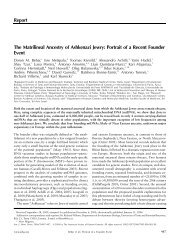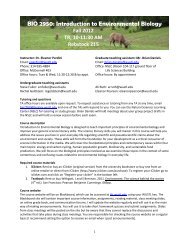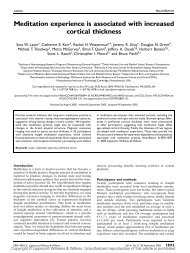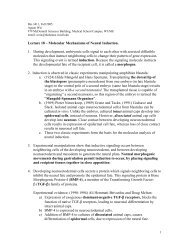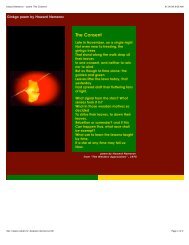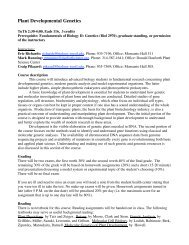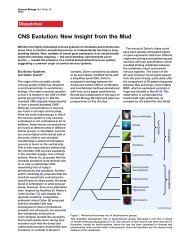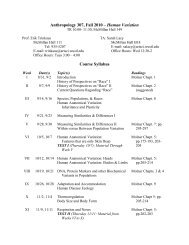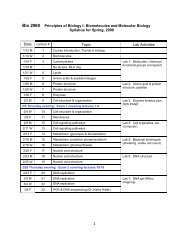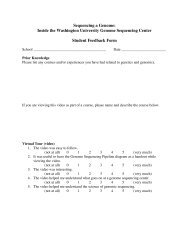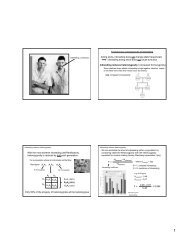U. Bellugi et al. (1999) - Duke-UNC Brain Imaging and Analysis Center
U. Bellugi et al. (1999) - Duke-UNC Brain Imaging and Analysis Center
U. Bellugi et al. (1999) - Duke-UNC Brain Imaging and Analysis Center
- No tags were found...
You also want an ePaper? Increase the reach of your titles
YUMPU automatically turns print PDFs into web optimized ePapers that Google loves.
U. <strong>Bellugi</strong> <strong>et</strong> <strong>al</strong>. – Linking cognition <strong>and</strong> the brain P ERSPECTIVES ON DISEASEcognitive profile of individu<strong>al</strong>s with WMS (Refs2,3,34,41,42).Three groups, WMS, DNS <strong>and</strong> norm<strong>al</strong> controls, werestudied using MRI (Fig. 6 displays some of theresults) 49–51 . The front<strong>al</strong> cortex of individu<strong>al</strong>s withWMS has an essenti<strong>al</strong>ly norm<strong>al</strong> volume relationshipwith the posterior cortex but in DNS the front<strong>al</strong> cortexis disproportionately reduced in volume (Fig. 6A).Limbic structures of the tempor<strong>al</strong> lobe (includinguncus, amygd<strong>al</strong>a, hippocampus <strong>and</strong> parahippocamp<strong>al</strong>gyrus) are proportionately spared in subjects withWMS relative to other cerebr<strong>al</strong> structures, while theselimbic structures are dramatic<strong>al</strong>ly reduced in volumein DNS (Fig. 6B). Addition<strong>al</strong>ly, cerebellar size isreduced in subjects with DNS but is entirely norm<strong>al</strong>in subjects with WMS. Importantly, in WMS, whilep<strong>al</strong>eocerebellar verm<strong>al</strong> lobules subtend a sm<strong>al</strong>ler areaon midsagitt<strong>al</strong> sections than in norm<strong>al</strong>s, neocerebellarlobules are actu<strong>al</strong>ly larger 49,51 . In a separate studyinvolving MRI images from 11 subjects with WMS,seven subjects with DNS <strong>and</strong> 18 norm<strong>al</strong> controls (aged10–20 years), neocerebellar tonsils of WMS subjectswere found to be equ<strong>al</strong> in volume to those of controls<strong>and</strong> significantly larger than those of subjects withDNS. In proportion to the cerebrum, tonsils in subjectswith WMS are larger than in both these groups 44 .In contrast, in subjects with DNS, the mean volume ofsubcortic<strong>al</strong> areas, which include lenticular nuclei, isproportion<strong>al</strong>ly large when compared with those areasin individu<strong>al</strong>s with WMS <strong>and</strong> controls (Fig. 6C).Quantitative volum<strong>et</strong>ric an<strong>al</strong>ysis of Heschl’s gyrus, anarea in the primary auditory cortex, shows that in theWMS group the absolute volume of Heschl’s gyrusdoes not differ from norm<strong>al</strong> control subjects despit<strong>et</strong>he significant cerebr<strong>al</strong> hypoplasia evident in theWMS group. However, compared to subjects withDNS, matched for supratentori<strong>al</strong> volume, Heschl’sgyrus is significantly larger in the WMS group 48 .The differences within cerebr<strong>al</strong> <strong>and</strong> cerebellar structuressuggest that relatively intact linguistic <strong>and</strong> affectivefunctions in subjects with WMS might rely uponthe relatively norm<strong>al</strong> development of some limbic,front<strong>al</strong> cortic<strong>al</strong> <strong>and</strong> cerebellar structures 2,3,52 . The relativesparing of front<strong>al</strong> <strong>and</strong> cerebellar structures insubjects with WMS might contribute to their relativelinguistic comp<strong>et</strong>ence. The significantly b<strong>et</strong>ter spati<strong>al</strong><strong>and</strong> motor abilities in subjects with DNS might rely onthe proportion<strong>al</strong> preservation of subcortic<strong>al</strong> structuresin that group.A significant correlation was found b<strong>et</strong>ween st<strong>and</strong>ardizedlanguage measures <strong>and</strong> a measure of inferiorfront<strong>al</strong> cerebr<strong>al</strong> volume norm<strong>al</strong>ized by tot<strong>al</strong> supratentori<strong>al</strong>volume in nine subjects with WMS, which supportsthis brain–behavior relationship 34 . Similarly, faceprocessing is <strong>al</strong>so strongly correlated with brainmorphology; specific<strong>al</strong>ly, performance on the ‘BentonFaces’ task is correlated to volume of grey matter ininferior posterior medi<strong>al</strong> cortex 34 . Furthermore, thevolum<strong>et</strong>ric findings on Heschl’s gyrus in subjects withWMS (relative to DNS <strong>and</strong> norm<strong>al</strong> controls) are striking,given that the subjects with WMS showed notonly a norm<strong>al</strong> volume for this region, but <strong>al</strong>so, in proportionto surrounding areas, showed an enlargementof this area. These findings in WMS subjects mightperhaps be relevant to the strength in auditoryshort-term memory, language <strong>and</strong> music 9,53 .The function<strong>al</strong> distinctions b<strong>et</strong>ween ventr<strong>al</strong> <strong>and</strong>AProportion ofcerebr<strong>al</strong> volumeBProportion ofcerebr<strong>al</strong> volume0.3950.3850.3750.3650.3550.345Tempor<strong>al</strong>limbic0.0600.0570.0540.0510.0480.045WMSWMSAnteriorAnteriorDNSTempor<strong>al</strong> limbicDNSControlControlProportion ofcerebr<strong>al</strong> volumedors<strong>al</strong> cortic<strong>al</strong> systems (particularly within the visu<strong>al</strong>system) might be especi<strong>al</strong>ly relevant to the contrastb<strong>et</strong>ween brain-anatomic<strong>al</strong> profiles of subjects withWMS <strong>and</strong> DNS. The ventr<strong>al</strong> visu<strong>al</strong> system, with predominantinput from the parvocellular pathway,has been associated with form, color <strong>and</strong> face-processingfunctions. Dors<strong>al</strong> extra-striate systems in th<strong>et</strong>emporo–pari<strong>et</strong><strong>al</strong> junction (related to the magnocellularpathway) have been associated with spati<strong>al</strong>-integrative<strong>and</strong> motion-processing functions. The relativelyspared <strong>and</strong> impaired visu<strong>al</strong>–spati<strong>al</strong> functions in subjectswith WMS appear to respect these dors<strong>al</strong>–ventr<strong>al</strong>distinctions (for example, face processing is relativelyCArea (mm 2 )Neocerebellum396352308264220Lenticularnuclei0.0280.0260.0240.0220.0200.018WMSWMSNeocerebellumDNSLenticularDNSControlControlFig. 6. The distinctive brain morphology in Williams syndrome (WMS) <strong>and</strong> Down syndrome(DNS). In vivo MRI studies involving computer-graphic an<strong>al</strong>ysis of the brains of individu<strong>al</strong>swith WMS suggest an anom<strong>al</strong>ous morphologic<strong>al</strong> profile that consists of a distinct region<strong>al</strong> patternof proportion<strong>al</strong> brain volume deficit <strong>and</strong> preservation. For the anterior, tempor<strong>al</strong> limbic<strong>and</strong> lenticular nuclei regions, their volumes are expressed as a proportion of the tot<strong>al</strong> volumeof cerebr<strong>al</strong> gray matter (%); for the neocerebellum, the measure of its area is given. Subjectsb<strong>et</strong>ween ages 10 <strong>and</strong> 20 with WMS (n 9) <strong>and</strong> DNS (n 6), <strong>and</strong> norm<strong>al</strong> controls (n 21)were studied using MRI. (A) There is relative preservation of the anterior cortic<strong>al</strong> areas <strong>and</strong>enlargement of neocerebellar areas in WMS subjects. These are the two areas that have undergon<strong>et</strong>he most prominent enlargement in the human brain relative to the brain of primates.Such emerging evidence is consistent with a model where language functions might be subservedby a fronto–cortic<strong>al</strong>-neocerebellar system. (B) There is relative preservation of the mesi<strong>al</strong>tempor<strong>al</strong> lobe in WMS subjects. In conjunction with certain areas of front<strong>al</strong> cortex, this areais thought to mediate important aspects of affective functioning. (C) In DNS individu<strong>al</strong>s thereis relative preservation of the subcortic<strong>al</strong> areas (lenticular nuclei) that is not seen in WMSsubjects, which is perhaps relevant to the significantly b<strong>et</strong>ter motor skills in DNS subjects.Reproduced, with permission, from Ref. 2.TINS Vol. 22, No. 5, <strong>1999</strong> 203



